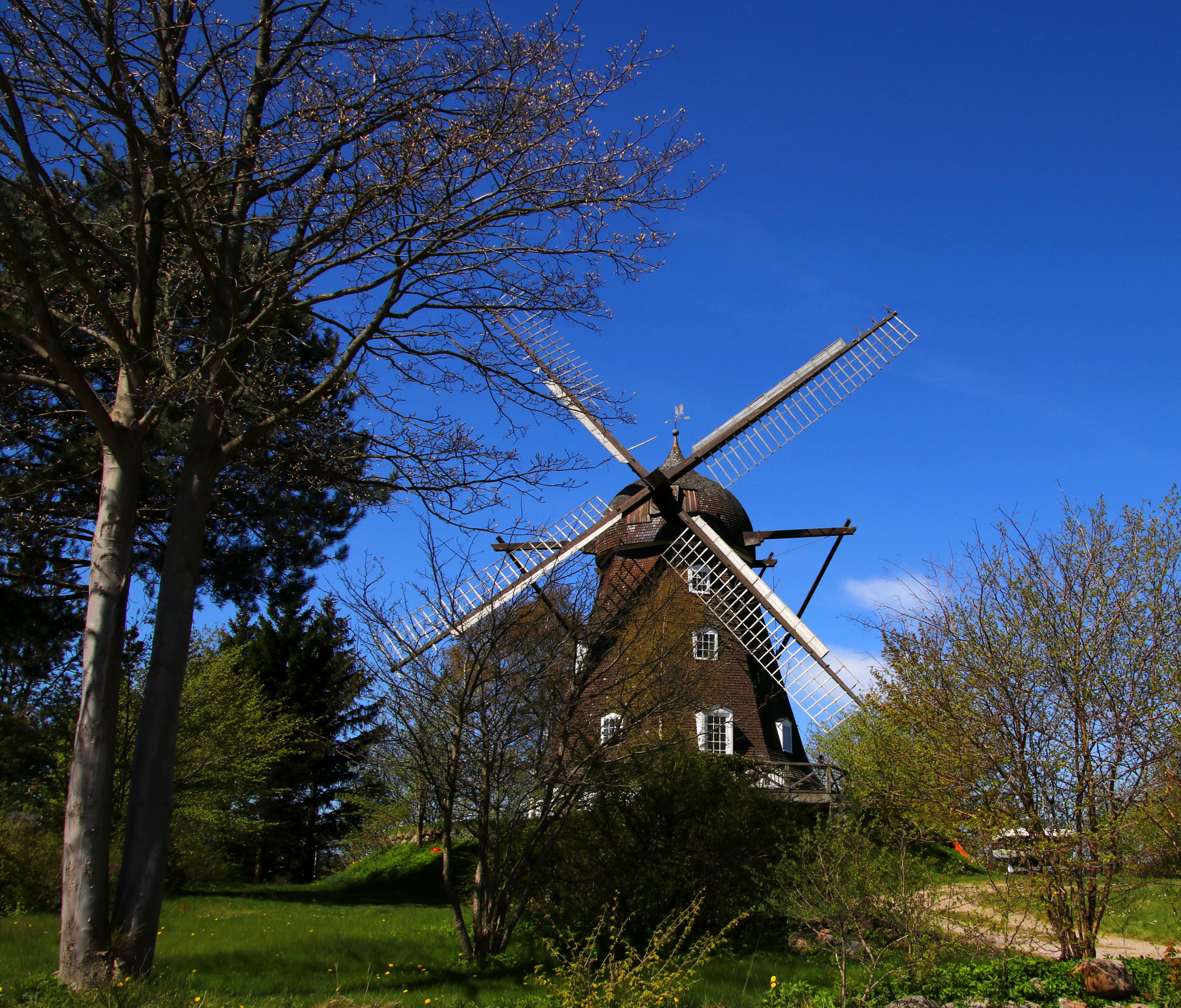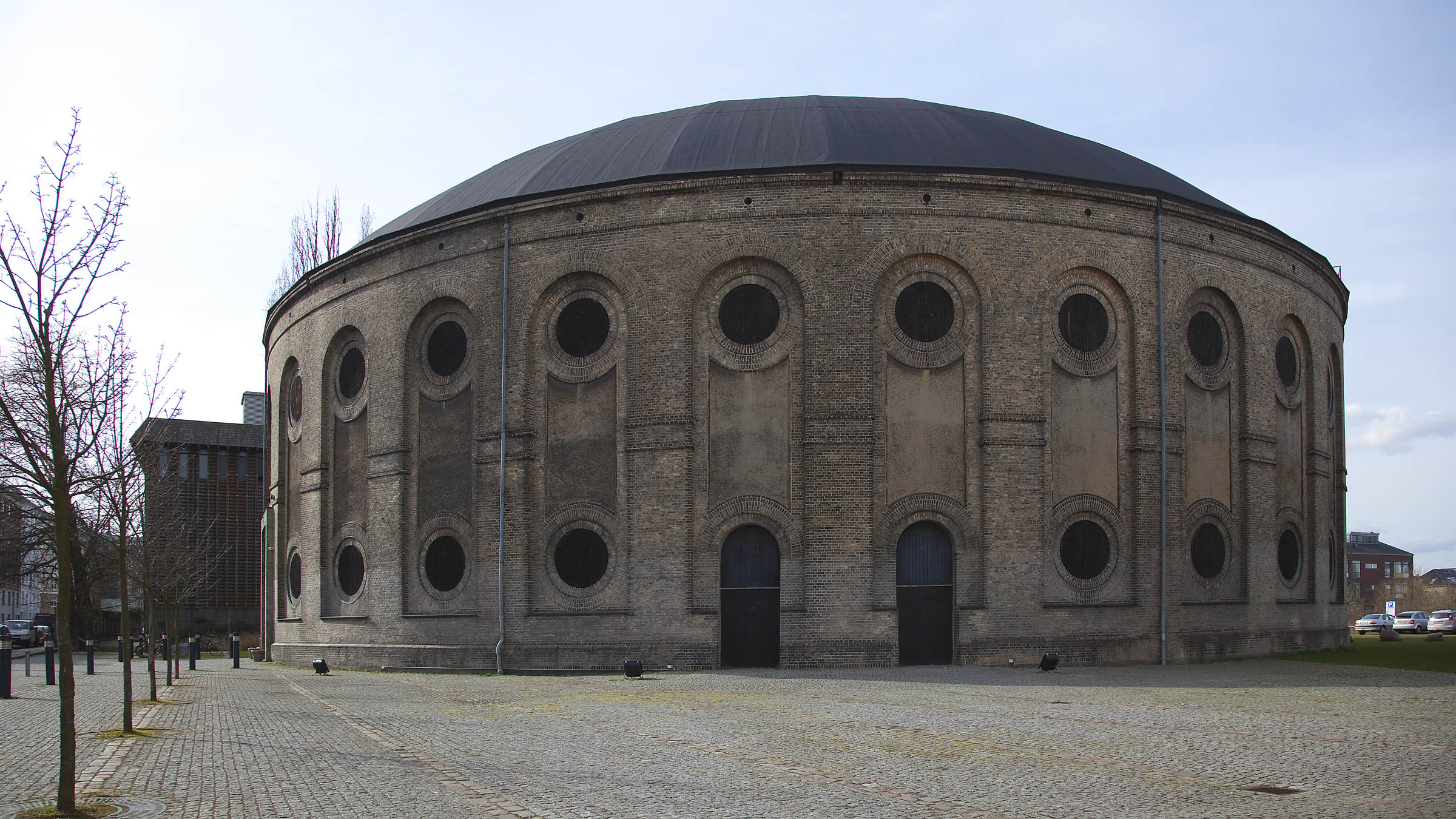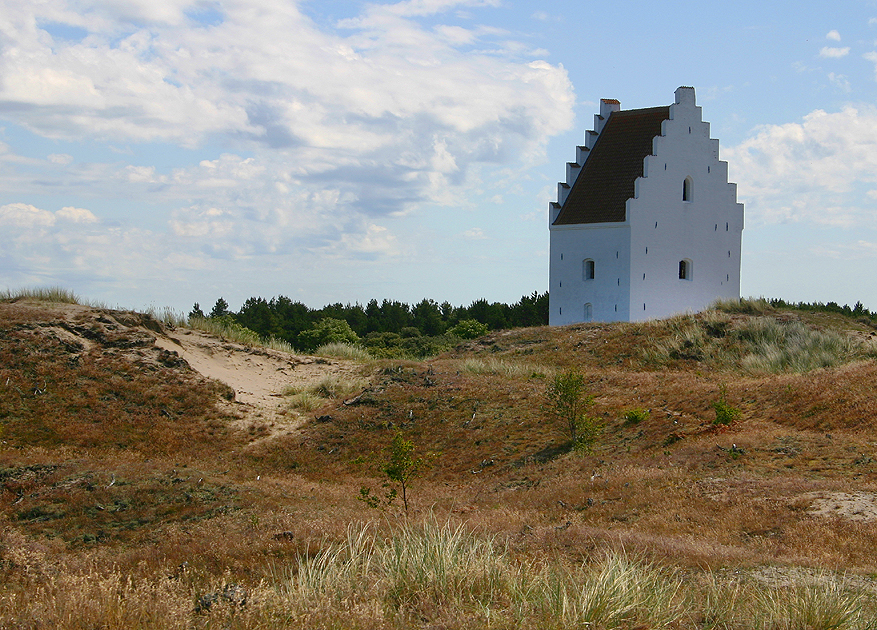|
Rytterhuset
Rytterhuset (literal translation, lit. "The Rider's House"), located at Nordre Strandvej 230, Ålsgårde, Helsingør Municipality, Denmarkm was built in 1889 to a Romantic Nationalism, national romantic design by Martin Nyrop as summer residence for the painter Frants Henningsen. The property, including a detached atelier, a jetty with a bathhouse and a number of other outbuildings, were listed in the Listed buildings in Helsingør Municipality, Danish registry of protected buildings and places in 1993. The ample use of wood ornamentation and polychrome, polychromy are both tell-tale features of this particular architectural style. The name of the building was inspired by a relief of a horseman located above the main entrance. Barbicaia at Nordre Strandvej 232 dates from the same year and was also designed by Nyrop but has undergone considerable alterations and is therefore not listed. History Frants Henningsen and his friends Peder Severin Krøyer, P. S: Krøyer, Viggo Johans ... [...More Info...] [...Related Items...] OR: [Wikipedia] [Google] [Baidu] |
Ålsgårde
Ålsgårde is a former fishing village on the north coast of Zealand, Denmark, located six kilometer northwest of Helsingør. Formerly Ålsgårde was a separate town, but today it has merged with the neighbouring town of Hellebæk into an urban area with a population of 5,790 (1 January 2022). Notable buildings Rytterhuset (Nordre Strandvej 230) iwas built in 1889 as summer residence for the painter Frants Henningsen to a National Romantic design by Martin Nyrop. The property, including a jetty with a bathhouse and a couple of outbuildings, is now listed in the Danish registry of protected buildings and places. Nordre Strandvej 140, a half-timbered house from 1819, is also listed. Hellebæk Church is, in spite of its name, also located in Ålsgårde. Notable people * Laura Kieler (1849 – 1932 in Ålsgårde) a Norwegian-Danish novelist * August Hassel August Christian Valdemar Hassel (9 February 1864 – 30 May 1942) was a Danish sculptor. Early life and education H ... [...More Info...] [...Related Items...] OR: [Wikipedia] [Google] [Baidu] |
Listed Buildings In Helsingør Municipality
This is a list of listed buildings in Helsingør Municipality, Denmark. The list Espergærde, 3060 Espergærde 3999 Helsingør 3100 Hornbæk 3140 Ålsgårde 3150 Hellebæk 3490 Kvistgård References External links Danish Agency of CultureStengade 76 {{DEFAULTSORT:Listed buildings in Helsingor Municipality Listed buildings and structures in Helsingør Municipality, Lists of listed buildings in Denmark, Helsingor ... [...More Info...] [...Related Items...] OR: [Wikipedia] [Google] [Baidu] |
Martin Nyrop
Martin Nyrop (11 November 1849 18 May 1921) was a Danish architect. Early life and education Nyrop was born on 11 November 1849 at Holmsland, Ringkøbing, the son of parish priest Christopher Nyrop (1805–1879) and Helene Ahlmann (1807–1874). He attended Sorø Academy and matriculated from the Royal Danish Academy of Fine Arts in 1876. From 1881 to 1883, he studied abroad on a scholarship from the academy. Career From 1883 to 1893, Nyrop worked as an assistant for professor Hans Jørgen Holm but was at the same time able to work on his personal commissions. Most of his early independent works were single-family detached homes. He experienced a breakthrough when he won the competition for the design of the buildings at the Nordic Exhibition of 1888. He constructed all his exhibition pavilions of wood at a time when iron and glass was favored for temporary structures. He justified the decision by claiming the result would be prettier for the same cost. His background as a car ... [...More Info...] [...Related Items...] OR: [Wikipedia] [Google] [Baidu] |
Skagens Museum
Skagens Museum is an art museum in Skagen, Denmark, that exhibits an extensive collection of works by members of the colony of Skagen Painters who lived and worked in the area in the late 19th and early 20th centuries. Important artists include Marie and P. S. Krøyer, Anna and Michael Ancher, Laurits Tuxen, Viggo Johansen, and Holger Drachmann. The museum also hosts special exhibitions. Its facilities include a café in the Garden House, an old building which for a while served as home residence and studio of Anna and Michael Ancher. History Skagens Museum was founded on 20 October 1908 in the dining room at Brøndums Hotel. Among the founders were artists Michael Ancher, P.S. Krøyer and Laurits Tuxen, who were elected to form the first board of governors together with Victor Christian Klæbel, the local pharmacist, and Degn Brøndum, proprietor of Brøndums Hotel and Anna Ancher's brother. The idea was to collect works by the Skagen Painters and to raise funds for the constr ... [...More Info...] [...Related Items...] OR: [Wikipedia] [Google] [Baidu] |
Nordic Exhibition Of 1888
The Nordic exhibition of Industry, Agriculture, and Art of 1888 (''Den Nordiske Industri-, Landbrugs- og Kunstudstilling i Kjøbenhavn 1888'') was an exhibition that aimed to feature the best of art, industry, and agriculture from the five Nordic countries. It was a joint-venture between 29 organisations and institutions, with the weight on the private side, represented foremost by the Association of Copenhagen Industrialists. The exhibition was located in Copenhagen, Denmark. Influence of national responsibility In the spring of 1883, the theme of the exhibition was narrowed down to be an idea fostered by (1838-1922) who served as Chairman of the Association of Copenhagen Industrialists and Vice President of the expo. Philip Schou was the founding owner of the faience or earthenware pottery factory Aluminia in Christianshavn. In 1882, the owners of Aluminia purchased the Royal Copenhagen porcelain factory. It was pointed out by Philip Schou that the expo took place to cre ... [...More Info...] [...Related Items...] OR: [Wikipedia] [Google] [Baidu] |
Bargeboard
Bargeboard (probably from Medieval Latin ''bargus'', or ''barcus'', a scaffold, and not from the now obsolete synonym "vergeboard") or rake fascia is a board fastened to each projecting gable of a roof to give it strength and protection, and to conceal the otherwise exposed end grain of the horizontal timbers or purlins of the roof. History Historically, bargeboards are sometimes moulded only or carved, but as a rule the lower edges were cusped and had tracery in the spandrels besides being otherwise elaborated. An example in Britain was one at Ockwells in Berkshire (built 1446–1465), which was moulded and carved as if it were intended for internal work. Modern residential rake fascias are typically made of 2-by dimensional lumber, with trim added for decoration and/or weatherproofing later. See also * Antefix * Cornice * Eaves * Fascia * Karamon – use in Japanese architecture * Soffit A soffit is an exterior or interior architectural feature, generally the horiz ... [...More Info...] [...Related Items...] OR: [Wikipedia] [Google] [Baidu] |
Strandgade
Strandgade ( lit. "Beach Street") is one of the principal streets in the Christianshavn district of Copenhagen, Denmark. It runs along the full length of the neighbourhood, following the harbourfront, from Christian's Church in the south-west to Grønlandske Handels Plads in the north The northern part of the street is a cul-de-sac for motor vehicles while a bridge for pedestrians and cyclists across Trangraven is currently under construction. History Origins Strandgade is one of the streets seen in Johan Semp's plan for Christianshavn from 1617. The original intention was only to build along the south-east side of the street, away from the water, while the beach provided private harbour facilities for the lot owners, who could easily transfer goods from ships to their warehouses and storage cellars. This solution was repeated along both sides of Christianshavn Canal. The lots along the street did not sell well and in the end the king gave them away to wealthy citizens from ... [...More Info...] [...Related Items...] OR: [Wikipedia] [Google] [Baidu] |
Behagen House
The Behagen House is a Neoclassical townhouse located at Strandgade 26 in the Christianshavn neighbourhood of Copenhagen, Denmark. The building was listed on the Danish registry of protected buildings and places in 1918. History origins Two houses similar to the neighbouring Sigvart Grubbe House at No. 28 were built at the site by Sigvart Grubbe in 1626. One of the properties was listed as No. 19 in Copenhagen's first cadastre of 1689 and was at that time owned by one ''schoutbynacht'' Dreier. The other one was as No. 20 owned by soap manufacturer Peder Hansen. The old No. 10 was listed as No. 36 in the new cadastre of 1756 and was at that time owned by a widow named Hegelund. The old No 20 was as No. 37 owned by ''etatsråd'' Frederik Holmsted. Holmsted owned the property from 1739 to 1769. Behagen family In 1759, Gysbert Behagen, a wealthy merchant, acquired one of the two houses. In 1764, he obtained a royal licence to establish a sugar refinery in the yard. In 1768, Beh ... [...More Info...] [...Related Items...] OR: [Wikipedia] [Google] [Baidu] |
Thorkild Henningsen
Thorkild Henningsen (7 February 1884 – 27 January 1931) was a Danish architect. He is best known for his design of numerous terraced housing developments, especially Bakkehusene at Bellahøj whish is listed on the Danish Registry of Protected buildings and Places. In spite of his early death, he also had a significant influence on Danish residential architecture of the 1920s through his work for Landsforeningen Bedre Byggeskik as well as through his writings in newspapers, architectural journals and ''Kritisk Revy''. Early life and education Henningsen was born on 7 February 1884 in Copenhagen, the son of painter Frants Henningsen (1850–1908) and Thora Vermehren (1859–1943). He attended Teknisk selskabs skole og Gustav og Sophus Vermehrens Forberedelsesskole before enrolling at the Royal Danish Academy of Fine Arts in 1903. He left the Academy after a few years without graduating, and was instead trained in H. Storck's architectural practice. After joining Heinrich Wenck's o ... [...More Info...] [...Related Items...] OR: [Wikipedia] [Google] [Baidu] |
Frederik Vermehren
Johan Frederik (Frits) Nikolai Vermehren, also known as Frederik Vermehren (12 May 1823 – 10 January 1910), a genre and portrait painter in the realist style. His artistic career took place during the period of Danish art known as the Golden Age of Danish Painting. Vermehren, along with his fellow artists Christen Dalsgaard (1824–1907) and Julius Exner (1825–1910), were prominent in the Danish genre of painting; they depicted ordinary people of the country, especially farmers and other country folk. His idealised depictions helped define and encourage Denmark's period of national romanticism. Early life Vermehren was born on the island of Zealand at Ringsted, Denmark. He was the son of Peter Frederik Nikolai Vermehren and his wife, Sophie Amalie Franck. At a young age, Vermehren worked in his father's workshop and did not have much opportunity to draw. However, he impressed Jørgen Roed (1808–1888), an artist who came from the same area. He began his artistic traini ... [...More Info...] [...Related Items...] OR: [Wikipedia] [Google] [Baidu] |
Skagen
Skagen () is Denmark's northernmost town, on the east coast of the Skagen Odde peninsula in the far north of Jutland, part of Frederikshavn Municipality in Nordjylland, north of Frederikshavn and northeast of Aalborg. The Port of Skagen is Denmark's main fishing port and it also has a thriving tourist industry, attracting 2 million people annually. The name was applied originally to the peninsula but it now also refers to the town. The settlement began during the Middle Ages as a fishing village, renowned for its herring industry. Thanks to its seascapes, fishermen and evening light, towards the end of the 19th century it became popular with a group of impressionist artists now known as the Skagen Painters. In 1879, the Skagen Fishermen's Association was established with the purpose of facilitating the local fishing industry through the Skagensbanen railway, which opened as a narrow-gauged railway in 1890. The modern port of Skagen opened on 20 November 1907, and with ... [...More Info...] [...Related Items...] OR: [Wikipedia] [Google] [Baidu] |








